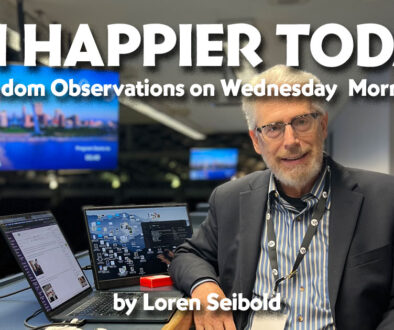Does Adventist Flood Geology Make Sense? Part 3: Of YEC & Miracles
by Rich Hannon | 23 July 2024 |
My two-part essay (read part 1 here, and part 2 here) last week on Young Earth Creationism (YEC) and Noah’s ark received a lot of comments, and I thank you for your interactions. It is not an easy topic for Adventists, we who were raised to believe in a literal one-week creation just 6000 years ago.
Out of respect for all who commented, and who I couldn’t answer directly, let me address some of the questions you raised here in a third installment of this discussion.
My purpose in writing
First, you may be asking: what was this guy actually trying to address in these essays—and what was he not trying to address?
I started by referencing Fundamental Belief #6, and suggested that the broader idea of YEC actually surrounds this statement. Next, I quoted a representative description of what supposedly happened during the flood, and proposed that YEC, and thus Adventism, views this scenario as theologically necessary.
I spent the bulk of the two-part piece considering three mechanisms that YEC claims produced the result seen in the geologic column:
- depending entirely on one small vessel,
- a flood,
- everything accomplished in a year.
Please note that it’s YEC proposing largely naturalistic processes to undergird their hypothesis. They want to be seen as scientific, because conventional geology/paleontology tells a radically different story—and implicitly produces a disturbing theological problem.
But here’s what I was not discussing:
Miracles.
Since I wanted to keep the articles to a manageable length, I narrowed my thinking about what to say and not say. I should have anticipated that my silence concerning the miraculous would produce some adverse reaction.
Because, of course, there is a miracle involved. I wasn’t suggesting otherwise. But the real issue is where and how the miraculous should legitimately be applied.
Commenters who imputed a naturalistic bias to me because I was silent about miracles went too far. Silence cannot fairly be used to infer someone has a specific position. It should connote neutrality—full stop.
But I wish I’d realized the issue of miracles was an important qualifier, and then addressed it. Since discussion of the miraculous was sprinkled all through the comments, let’s consider two of the problems in this regard.
#1. God the deceiver
The idea that God can do whatever, and we shouldn’t question it, has the advantage of shutting down discussion about mechanism. But it assumes what it needs to prove. In this context, the argument starts with YEC being true, and tries to employ unconstrained miracle to force a slam-dunk conclusion—since who are we to question God?
But YEC is not the same as the actual Genesis story, as I tried to point out. It is a hypothesis and, as such, postulates a result and provides a supposed bridge from premise to conclusion. Most of the article was to address this hypothesis, and demonstrate why I found it severely wanting.
The problem with YEC appealing to God’s unlimited abilities is that the actual result is wildly inconsistent with what they claim the divine mechanism was. So, if YEC seems necessary for religious reasons, you’re also stuck with evidence in the ground that is unaligned with the supposed God-action—like that floods don’t produce aeolian deposition.
Yet this appears to be deceptive on God’s part. Why would God leave behind a physical reality that’s inconsistent with the presumed process—a flood? But we cannot impute an unethical character to God. So, if you want an unconstrained God to buttress YEC, you might also have an ethics problem.
#2. Patching with miracle
There’s a famous cartoon where two mathematicians are looking at a “proof” written on the blackboard. There’s a snarl of equations on the left, and an equally tangled collection on the right. In the middle it says, “Then a miracle occurs.” One guy tells the other (who evidently wrote it all), “I think you should be more explicit here in step two.”
This humorously captures a conundrum. Sometimes a miracle does occur. But there is also a human temptation to shore up our hypotheses with miracle, when all else (like defensible naturalistic causation) fails. YEC has struggled with this: for example, when John Baumgardner’s Runaway Subduction model failed the test of physics. He finally conceded the need for miracle to “save” his hypothesis.
We need to be wary of our all-too-human tendency to hold onto problematic theological positions by trying to find rescue via a miracle. It can become such a patchwork that an uninvested observer might ask: “Why don’t you just rethink this more foundationally?”
Overlapping magisteria
The word “magisteria” means “teaching authority.” In the context of faith and science there is an overlap in authority. Most of religion deals with ethics and special God-pronouncements we couldn’t know otherwise. Science, by definition and necessity, deals strictly with the physical world.
But this physical world is the overlap, and that’s where contention arises.
Steven J. Gould famously coined the term NOMA, standing for: Non-Overlapping MAgisteria. It proposes that any conflict between science and religion, in the overlapping physical realm, can be resolved by considering them to be non-overlapping. And to do that we should cede this middle ground—to science.
Well, how convenient! But why should religion ever do this? If God actually has given information about physical reality, then this is a superior authority to man’s ideas. Obviously. By definition.
But the above argument, which gets employed pervasively by religionists, also has problems. Please note what I wrote in the article:
“But while the revelatory texts can be considered God-derived, and science isn’t, both sources are interpreted by fallible humans. And that reality ought to force this conclusion: the stronger the case for one authority, the more the other should be reconsidered.”
I’ve written variations of this elsewhere, seemingly until I am blue in the face. It should be self-evident that, even though God has delivered revelation to us, such material is filtered through fallible humans—you and me. Consequently, we have to fairly consider the weight of evidence from both magisteria.
So how might that work with revelatory material? Here’s where some of my early statements in the essay are relevant:
“It would seem to be a “plain reading” that the days of creation are literally 24 hours long. … Then, in describing the flood’s scope, the English word used is “earth.” For moderns, this would seem to reference the entire planet. It takes further deliberation (e.g., reading a book like God, Sky, and Land) to reconsider this. But such time-consuming investigation and revisionism risk can be both daunting and disturbing.”
And there are many other books, such as The Lost World of Genesis One. These are revisionist in the sense that they address aspects of the biblical text that were hardly recognized before modernity, but now should be factored into our reading of the Bible. However, as I said, this can be “both daunting and disturbing.”
What science is and isn’t
One commenter used the phrase “science has not arrived and can never arrive.” This was intended, as I read it, to deprecate the presumed authority of science, by emphasizing its changeability. The problem here is that the phrase is technically 100% true, but perhaps is being employed inappropriately.
Foundationally, science is an inductive process. It argumentatively proceeds from a bunch of specifics toward a generalization. The result is the theory. But, because the inference is inductive, it is also necessarily probabilistic and subject to revision.
To “arrive” implies certainty, which science never reaches. And we have changed our views on how the world works quite a lot over the centuries. But that reality is then often illegitimately employed to infer that science is really “all over the map,” and tomorrow it might reverse itself.
YEC likes to make such an argument to undermine confidence in the reasons conventional geology/paleontology draw their conclusions. But looking at the history of evolving (no pun intended) scientific knowledge, you don’t find continual reversal, although there are some major revisions, such as plate tectonics or Einsteinian physics.
It is a gross perversion of the reality that science is only probable, to then conclude that science is untrustworthy. YEC apologists wouldn’t really conclude this generally, in real life. Some just want to make this move when there is religious risk involved.
My view = God’s truth
There were a few strong categorical statements in the comments that YEC was the same as God’s Truth. Perhaps the strongest one I noticed was:
“What has happened to faith in an infinite God? Of course the earth was covered in water … how do I know? Because the Word of God says so.”
Please understand: this is not a personal criticism of this commenter. It is to say that in this comment there is a professed link between an overarching “faith in an infinite God” and the perceived necessity of affirming YEC because “the Word of God says so.”
But people like me who reject YEC don’t have a faith problem, per se—just a YEC problem.
The comment also assumes the word “earth” equates to “planet.” I pointed out this conflation explicitly in the essay. An opinion about the meaning of “earth” should not get elevated to God-grounded reality.
So, I refer you again to my argument about human fallibility. Everyone holds positions on what is true. But we really need to get rid of the pseudo-certainty that we’re tempted to attach to our ideas.
I am no relativist. I firmly believe there are certainties. But none of us have a God’s-eye view, and thus have no actual certainty. We only have beliefs, however well-grounded—or not—they might be.
Critiquing institutional Adventism
I ended my piece with a strong criticism of Adventist leadership’s intransigence in addressing difficult issues. And my essay elicited some comments inferring that I myself, and Adventist Today, weren’t adequately Adventist, because we were critiquing affirmed denominational orthodoxy.
But this viewpoint necessitates the conclusion that the church has arrived at 100% truth. I doubt even the ones writing such “you’re not Adventist enough” comments would posit that the church has no possible further need of correction. Maybe some would. But, if so, they then go counter to a famous Ellen White statement saying we have much to learn and unlearn.
Finally, a need for humility
We humans all, to varying extents, suffer from the Dunning–Kruger effect: we think we know more than we actually do, and are often blinded to this knowledge-gap. Of course, this applies to me too, not just others. The best we can do is reflect on such bias-potential and try to mitigate it.
But a movement like Adventism doesn’t make this task easy. There is a strong historical tendency in our subculture toward triumphalism. We are the “remnant church,” we have “the truth,” and honest seekers in the apostate churches need to “come out of Babylon” and join us. Such a narrative is hard to proclaim confidently if at the same time, you are wondering whether some things you were taught might actually be false.
But however problematic this is, we’re stuck with our humanity and we do make errors in belief. Everyone then ought to be open to the possibility of correction while, of course, avoiding being “tossed to and fro, and carried about with every wind of doctrine” (Eph. 4:14 KJV). This takes effort and discernment.
It also takes genuine humility. When challenges to orthodoxy come to our attention—exemplified by my article—it is difficult to react dispassionately. But fairness in consideration is needed. And that’s not easy.
 Rich Hannon is a retired software engineer. His long-standing avocations include philosophy, geology, and medieval history.
Rich Hannon is a retired software engineer. His long-standing avocations include philosophy, geology, and medieval history.




